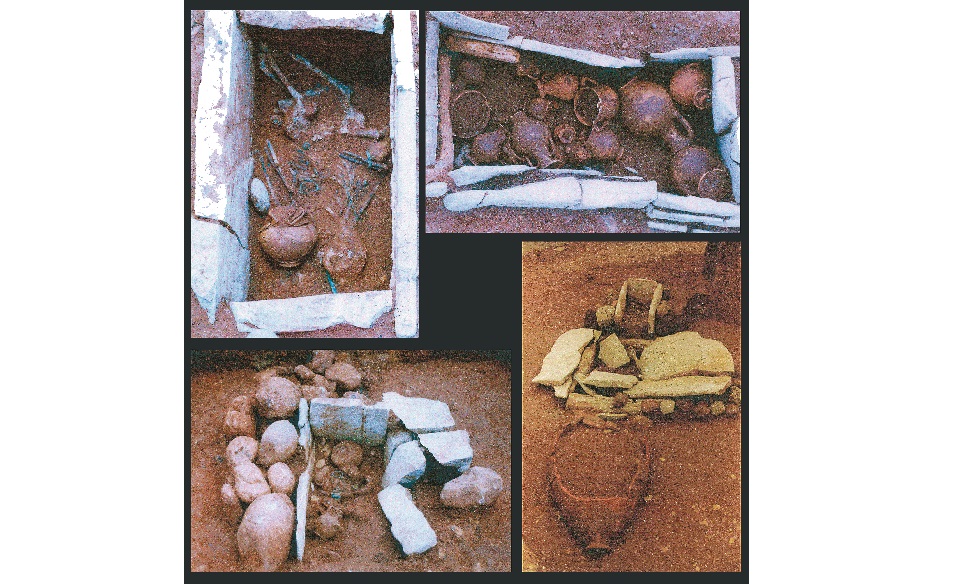Greek archaeologists awarded Harvard fellowship to study Early Iron Age pottery

Archaeologists Gioulika Christakopoulou of the Achaean Ephorate of Antiquities and Helene Simoni of the University of Patras have every reason to be happy these days, despite the massive workload facing them. They recently found out that a research proposal they had submitted last year to the University of Harvard’s Center for Hellenic Studies is getting the backing they want. Now they’re preparing to leave for the United States in January to work on the project, titled “Cracking the Code: Symbols, meanings and networks in Early Iron Age Greece – Evidence from the Stamna Pottery.” This entails attempting a first approach to uncover the cultural significance of the individual and recurring motifs/symbols that adorned 709 ceramic vases at Stamna, Aetolia. These artifacts were yielded from the excavation of 500 tombs.
“At first glance, the patterns may appear to be simple linear designs arranged at various heights along the periphery of the vases. However, upon closer observation of the whole, they reveal an inspired geometric design in both conception and execution,” they explain.
‘The aristocracy never missed an opportunity to demonstrate a connection to the heroic past’
Intrigued by the wealth of finds from the Stamna site, artifacts that have been associated with the local elite and have revealed much information on the area’s cultural complexity during the Iron Age, the two archaeologists wonder if the motifs they are studying stem from artistic inspiration, were the result of observations of geometric patterns that appear in nature or are, ultimately, the legacy of an earlier civilization in Stamna that went on to grow and evolve.
“The Mycenaean and Homeric traditions are firmly rooted in this geographical area, and the aristocracy never missed an opportunity to demonstrate a connection to the heroic past and to showcase their Mycenaean origins,” they explain.
In this respect, the questions being posed by the researchers open up fascinating lines of inquiry: “Given that Stamna was at a peak in the period being investigated, were these decorative motifs, among others, the link that described the privilege of a specific elite against those in other contemporary settlements in the wider vicinity? And, if so, from a social analysis perspective, could the motifs decorating Stamna’s pottery be used as special indicators of this specific elite, were they symbols of social status that had been carefully selected so as to represent the position of this elite and its contribution to society? Furthermore, what kind of relationships and flows were developed between Stamna and other centers in Greece and beyond in the Early Iron Age?”
Collective identity
The last question is particularly interesting, because the high level of skill and esthetic sophistication that distinguishes the recurring and symmetrical motifs of Stamna’s ancient pottery, according to the archaeologists, point to the collective identity and social beliefs of the broader geographical area of the Aegean and the Eastern Mediterranean. With this in mind, Christakopoulou and Simoni will investigate interpretations of the meaning and use of the motifs, whereby the pottery is treated “like a bearer of messages and symbols based on a particular code of communication.” What does this code refer to? Among others, “matters related to important stages of people’s lives, such as birth, marriage and death,” note the archaeologists. “The puzzle of pinpointing the provenance of a multitude of motifs from Stamna, but also from areas further away, reinforces our argument that they may have functioned as symbols of identity, encrypting social notions which extend across or beyond ethnic identities in the wider region of Eastern Mediterranean, the Aegean, Asia Minor etc,” they say.
Such interactions and communication mechanisms would serve multiple purposes, such as trade and economic transactions, creating social and cultural networks, promoting a spirit of cooperation and diplomacy, encouraging intellectual development and spiritual pursuits, allowing exchanges on religious beliefs etc.
These are not questions that can be answered in a few months, so Christakopoulou and Simoni have long-term plans to establish and lead an independent ‘lab’ that successfully studies the dissemination of the early Greek ceramic material Cculture, but will also be publishing their finds. “As far as the final publication of our discoveries is concerned, given the Center for Hellenic Studies’ commitment to excellence, we expect the research that will be carried out in the framework of the fellowship to be of the highest caliber and, therefore, to take a significant amount of time.”





